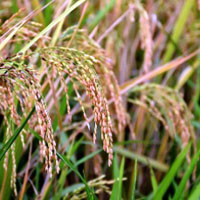Synthetic nitrogen coupled with seaweed extract and microbial inoculants improves rice (Oryza sativa L.) production under a dual cropping system

Accepted: 9 February 2021
PDF: 818
All claims expressed in this article are solely those of the authors and do not necessarily represent those of their affiliated organizations, or those of the publisher, the editors and the reviewers. Any product that may be evaluated in this article or claim that may be made by its manufacturer is not guaranteed or endorsed by the publisher.
The over-reliance on synthetic nitrogen (N) in current farming is a major concern because of its adverse effects on soil quality, the environment, and crop production. Organic fertilizers such as seaweed extract (SE) and microbial inoculants (MI) provide alternatives to chemical fertilizers that could decrease the amount of synthetic N needing to be applied and improve crop growth productivity. This study evaluated the combined effect of SE and MI with reduced N rates on the growth, biomass accumulation, yield, and yield components of an N-efficient rice cultivar (Baixiang 139-A) and N-inefficient rice cultivar (Guiyu 9-B). Field experiments were conducted in the early and late growing seasons at different sites in Guangxi province, China, in 2019. A total of five treatments, such as T1: N 180 + SE 0 + MI 0 (kg ha–1) (control); T2: N 180 + SE 3 + MI 3 (kg ha –1); T3: N 144 + SE 3 + MI 3 (kg ha–1); T4: N 126 + SE 3 + MI 3 (kg ha–1); and T5: N 108 + SE 3 + MI 3 (kg ha–1) were used. The leaf area index (LAI), effective panicle number, grain per spike, grain filling rate, and 1000-grain weight were significantly increased in T2 and T3 compared with the control. The treatments T2 and T3 enhanced the biomass accumulation and grain yield of rice compared with the control. Furthermore, differences in the growth, yield, and yield components among the different cultivars were significant; however, there were no significant differences among the different locations. T3 increased the LAI, grain filling rate, biomass accumulation, and grain yield of rice by 4.5%, 5.9%, 6.6%, and 5.2%, respectively, compared with the control. Improvements in grain yield were mainly attributed to the enhanced growth and yield components. The correlation analysis also confirmed that LAI, productive tillers, grain filling rate, and biomass accumulation were positively correlated with grain yield. In sum, T3 [N144 + SE 3 + MI 3 (kg ha–1)] could achieve higher grain yield despite a reduction in the usage of chemical N. Generally, this study provides a sustainable nutrient management plan that increases crop production while minimizing costs of chemical N fertilizer application.
Highlights
- This study assessed the combined effect of seaweed extraction and microbial inoculants with reduced chemical fertilizer rates on the rice production.
- Seaweed extraction coupled with chemical fertilizer significantly improved biomass accumulation and grain yield of rice.
- Seaweed extraction and microbial inoculants, combined with a 20% reduction in nitrogen fertilizer, improved rice growth and yield.
- The correlation analysis revealed that the growth and yields traits significantly contributed to the higher grain yield.
- This study provides a sustainable nutrient management plan that increases crop production while minimizing costs of chemical N fertilizer application.
How to Cite

This work is licensed under a Creative Commons Attribution-NonCommercial 4.0 International License.
PAGEPress has chosen to apply the Creative Commons Attribution NonCommercial 4.0 International License (CC BY-NC 4.0) to all manuscripts to be published.

 https://doi.org/10.4081/ija.2021.1800
https://doi.org/10.4081/ija.2021.1800



